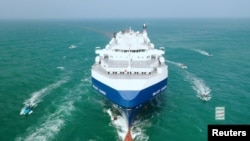Houthi drone and missile attacks on Red Sea shipping have spurred the development of an alternative “land bridge” to carry cargo by truck from the Persian Gulf across Saudi Arabia and Jordan to Israel and Egypt.
The project, which is already seeing dozens of trucks per day reach the Israeli port of Haifa, is seen as an early benefit of the 2020 Abraham Accords normalizing ties between the United Arab Emirates and Israel.
It bodes well for future cooperation between Israel and Saudi Arabia. The United States is seeking to broker a deal that would see the normalization of relations between those two countries in exchange for the establishment of a Palestinian state.
Saudi Arabia, however, has not commented publicly on the arrangement, under which cargo transported through the desert kingdom is not identified as bound for Israel.
The land bridge is already controversial in the region, sparking protests last week in Jordan among protesters angered over Israel’s conduct of its war against Hamas in Gaza.
Hundreds of individuals marched in Amman and other cities, demanding – among other things – that the government block any trucks originating from the Gulf states destined for Israel.
Efforts to establish the land route have been underway since at least the middle of 2023 but have picked up momentum since the Iran-backed Houthis began a wave of missile and drone attacks on Red Sea shipping. Several shipping firms are now rerouting their vessels around the African continent, adding substantially to time and costs, making the land route financially attractive.
Tim Seifert, a spokesperson at Hapag-Lloyd AG, one of the world’s leading liner shipping companies, said rerouting the firm’s vessels has left it with “an additional cost in a USD two-digit million range every month.”
The route was pioneered in part by Israeli company Trucknet Enterprises, which has secured agreements with DP World from the United Arab Emirates, Cox Logistics in Bahrain and WWCS in Egypt. Israel-based freight forwarder Mentfield Logistics is operating a similar route.
Under the arrangement, ships carrying goods from the Far East can unload their cargo onto Jordanian trucks in Dubai or Bahrain. The cargo is driven across Saudi Arabia and Jordan and then transferred onto Israeli trucks for the final leg from the Jordanian border to Israel’s Mediterranean port of Haifa. Cargo bound for Egypt can travel onward by road or ship to that country.
Mentfield CEO Omer Izhari told The Times of Israel this week that “dozens of trucks a day, not just by us, are facilitating this route to shorten shipping times for goods from textiles to electronics, raw materials for industry, metal pipes and aluminum.”
“The overland route saves around 20 days, so instead of 50 to 60 days, goods arrive within 20 to 25 days from China to Israel,” he said.
Barry Pintow, manager at the Israeli Federation of Forwarders and Customs Clearing Agents, said that the idea behind the land bridge is “brilliant,” but that the implementation is still problematic at a time of high tensions in the region.
“Currently, cargo moved by trucks leaving the UAE reach Haifa port via the Jordan River Bridge from Jordan, but they still face bureaucratic procedures, including required driver changes, paperwork and lengthy wait times,” he said.
“The idea is to enable the arrival of a single truck and driver from Dubai to the port of Haifa, for example, without changing drivers and trucks at border crossings between countries.”
Dean Davison, the head of Maritime Advisory for the London-based infrastructure development consultancy Infrata, said the success of the new trade route will require the “appropriate and strong support of respective governments.”
“The issues in the Red Sea may have helped the development of this new overland route come to fruition more quickly, though there has been strong interest in developing overland freight routes in the region for some time,” he said.
“I would expect this freight option to remain in place, even after the issues in the Red Sea are resolved.”










